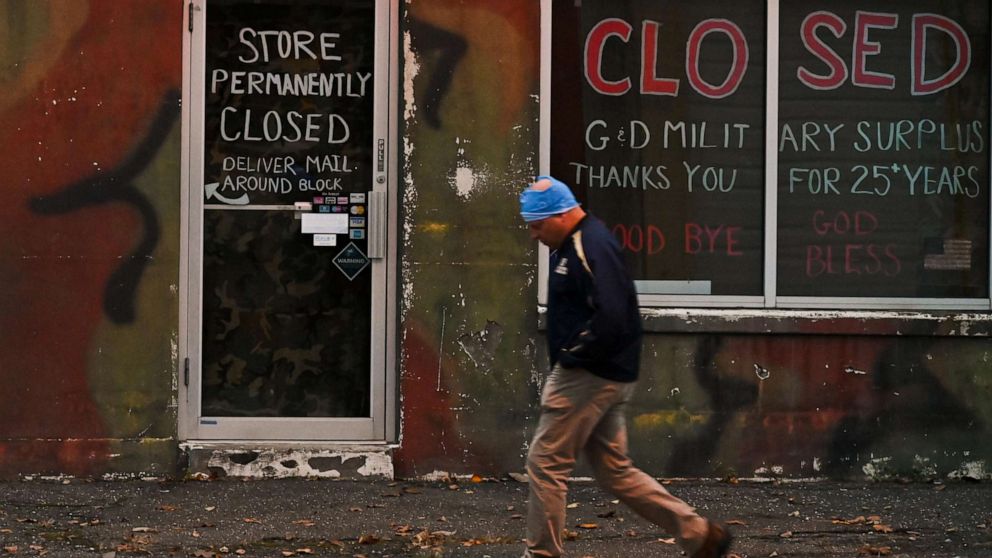Millions of Americans still rely on pandemic benefits set to expire this month
For Ricardo Ramirez, Dec. 31 looms large on the calendar.
Ramirez was furloughed from his job at the Westin hotel in San Antonio, Texas, in March and formally laid off in September. He's applied to hundreds of jobs since then, but he's competing with so many in the hard-hit hospitality industry for so few positions. He knows time is running out: the long-term unemployment benefits he's been able to receive thanks to the stimulus package Congress passed back in April run out at the end of the year.
"I feel like they have been playing with us instead of really taking care of us. It has been a political game that has been out there and it really has affected small businesses, individuals, and families," Ramirez told ABC News. "The message I can give them would be: think that we are your parents, think that we are your kids, your grandkids. This is America who is really getting affected. This is not a game. ... It's about time for them to do something for the community."
Without help, Ramirez fears the worst: losing the home and car he worked so hard to buy after being hit hard in the 2008 recession and possibly having to move in with his mother in Puerto Rico.

For millions of Americans like Ramirez, Congress' negotiation over a $908 billion coronavirus stimulus package is coming perilously close to the expiration of benefits they still rely on. From unemployment, to housing protection, to funding for state and local governments -- these programs are propping up already-struggling workers, and their expiration during and after the holidays could prove to be a major challenge for the economy, potentially leaving many in America without a safety net.
About two dozen CARES Act programs are set to expire at the end of the year, according to an analysis by nonpartisan organization Committee for a Responsible Federal Budget.
Here's a rundown of some of the key protections and benefits that expire soon:
Unemployment benefits
The most well-known unemployment provision in the CARES Act allowed laid-off workers to receive an extra $600/week payment in addition to state unemployment. That benefit expired at the end of July, but the CARES Act did create other unemployment benefit programs that millions of Americans are still receiving.
One program makes gig workers, like Uber drivers, freelancers and other self-employed workers eligible to receive state unemployment. Another extends unemployment eligibility for 13 weeks past a state's normal cut-off period.
The CARES Act ends these programs on Dec. 31, but because it is a Thursday and because benefits can only be paid out for a full Sunday-through-Saturday calendar week, recipients won't receive any benefits past the week ending Dec. 26.
More than 14 million Americans were enrolled in these two programs as of mid-November, according to Department of Labor data. The Century Foundation, a progressive Washington, D.C., think tank, estimated 12 million Americans will see these benefits expire on Dec. 26. The Century Foundation estimated another 4.4 million workers have already run out of CARES Act benefits.
This cutoff could have a significant effect on the economy. In the 2009 American Reinvestment and Recovery Act, benefit recipients were allowed to fulfill their full eligibility, receiving benefits after the end of the program, as long as they qualified for benefits before it ended. Recipients phased out of programs over time. But the CARES Act ends the program regardless of whether a recipient just started collecting unemployment one or two weeks ago, meaning all recipients will be cut off at the same time, potentially worsening the economic blow.
Protections for renters, homeowners
In September, the Centers for Disease Control and Prevention declared a moratorium of eviction of renters for non-payment due to COVID-19 financial hardship. The moratorium did not succeed in protecting all renters from eviction. It was able to be used as a defense in court, but interpreted broadly by judges across the country. Still, this moratorium is set to expire Dec. 31, stripping away one major protection for renters.
According to the National Low Income Housing Coalition, 6.7 million renter households will be at risk of eviction when the moratorium expires.

For homeowners with a mortgage backed by Freddie Mac or Fannie Mae, a foreclosure moratorium was extended by the Federal Housing Finance Agency until Jan. 31. That moratorium covers about 28 million homeowners.
Paid leave
The CARES Act required certain types of employers to provide two weeks of paid leave to those battling COVID-19, quarantining or caring for a loved one. Prior to this provision, millions of workers had no access to any type of paid leave. It also funded 10 weeks of partially paid child care leave.
At a time when COVID-19 cases are surging across the country, the left-leaning Center for American progress estimates that more than 60 million workers will lose these paid leave protections.
Student loans
Federal student loan payment was put on hold until Dec. 31, and interest rates were slashed to 0%. This provision never covered private student loans.
Small businesses
The forgiveness deadline for the popular Paycheck Protection Program is on Dec. 31 and businesses also face losing a variety of tax credits and tax-deduction increases.
A recent Census Bureau pulse survey of small businesses shows that 38% have experienced decreased revenue in the past week and three times as many small businesses reduced their employee numbers as those that increased. The U.S. Chamber of Commerce cited those figures in a letter to Congress on Monday as evidence that another emergency aid package is crucial for small businesses.
Bureau of Labor Statistics figures show that some industries remain incredibly hard hit. Employment in the movie production industry is down 43% from February, while air transportation jobs are down nearly 24% and employment at clothing stores is down 25%.

State and local government funding
The CARES Act gave $150 billion to state and local governments to use for many purposes, including testing sites, business aid and bailouts for workers. But if states haven't been able to spend their share by Dec. 31, they must hand the remaining money back over to the Treasury.
Multiple governors have called on the federal government to extend the deadline, especially as they realize how pricey it will be to distribute the vaccine.
There are 1.3 million fewer Americans who are currently employed in state and local government jobs now than were in February 2020. Without help from the federal government, cash-strapped states could be forced to cut budgets and even more jobs.
Trish Turner and Alexandra Busalacchi contributed to this report.




